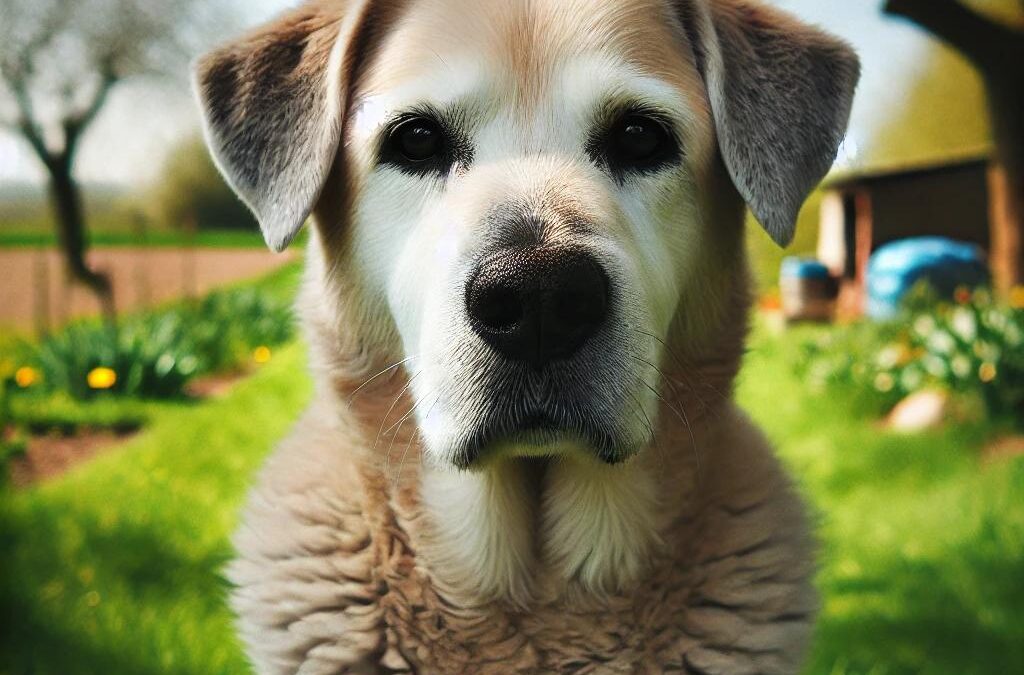
by TCMVET | Aug 14, 2024 | Dog Cancer & Tumors
Odontogenic tumors, though rare, can significantly impact your dog’s oral health if not detected and treated early. These tumors originate from the tissues involved in tooth development and can range from benign growths to more aggressive forms that can cause severe damage to the mouth and jaw. Early detection and prompt treatment are crucial to ensuring the best possible outcome for your dog. This article will guide you through the importance of recognizing the signs, understanding the diagnostic process, and exploring the treatment options available for odontogenic tumors in dogs.
Why Early Detection Is Critical
Early detection of odontogenic tumors is vital for several reasons:
- Preventing Disease Progression: Identifying tumors at an early stage can prevent them from growing larger or spreading, which can make treatment more difficult and invasive.
- Improving Treatment Outcomes: Tumors detected early are often easier to treat, with a higher likelihood of successful removal and lower risk of recurrence.
- Minimizing Discomfort: Early treatment can help alleviate any pain or discomfort your dog may be experiencing due to the tumor, improving their quality of life.
Recognizing the Signs of Odontogenic Tumors
Odontogenic tumors can present with a variety of symptoms, some of which may be subtle in the early stages. Common signs to watch for include:
- Swelling in the Mouth: Any unusual lumps or swelling in your dog’s mouth or on the gums should be examined by a veterinarian.
- Loose Teeth: Tumors can affect the structure of the jaw, causing teeth to become loose or displaced.
- Difficulty Eating or Chewing: If your dog shows reluctance to eat or appears to be chewing on one side of the mouth, it could be a sign of discomfort caused by a tumor.
- Bleeding Gums: Unexplained bleeding from the gums may indicate the presence of a tumor.
- Bad Breath (Halitosis): Persistent bad breath, especially if accompanied by other symptoms, should not be ignored.
Diagnostic Steps for Odontogenic Tumors
If an odontogenic tumor is suspected, your veterinarian will likely recommend several diagnostic steps to confirm the diagnosis and determine the appropriate course of treatment:
- Physical Examination: A thorough oral examination is the first step in identifying any abnormal growths or lesions in the mouth.
- Dental X-Rays: X-rays are essential for visualizing the extent of the tumor and assessing whether it has affected the underlying bone structure.
- CT Scans: For more detailed imaging, a CT scan may be recommended, particularly for tumors that are difficult to assess with standard X-rays.
- Biopsy: A biopsy involves taking a small sample of the tumor tissue for analysis. This step is crucial for determining the exact type of tumor and its aggressiveness.
Treatment Options for Odontogenic Tumors
The treatment of odontogenic tumors depends on several factors, including the type, size, and location of the tumor. Common treatment options include:
- Surgical Removal: The most common treatment for odontogenic tumors is surgical excision. The extent of surgery can vary depending on the tumor’s invasiveness, with more aggressive tumors requiring more extensive procedures.
- Radiation Therapy: In cases where the tumor is difficult to remove surgically or has a high risk of recurrence, radiation therapy may be recommended as an adjunct treatment.
- Post-Surgical Monitoring: After treatment, regular follow-up appointments are crucial to monitor for any signs of recurrence and to ensure that your dog’s recovery is progressing well.
Ensuring Your Dog’s Oral Health
In addition to early detection and treatment, maintaining good oral hygiene and regular veterinary check-ups are essential for preventing the development of odontogenic tumors and other oral health issues. Brush your dog’s teeth regularly, provide appropriate chew toys, and schedule routine dental cleanings with your veterinarian to keep your dog’s mouth healthy.
Odontogenic tumors, though rare, require prompt attention to ensure your dog’s oral health and overall well-being. By recognizing the signs early, seeking timely veterinary care, and following through with appropriate treatment, you can help safeguard your dog from the potential complications of these tumors.

by TCMVET | Aug 14, 2024 | Dog Cancer & Tumors
Odontogenic tumors in dogs are a group of rare but significant oral tumors that arise from the tissues involved in tooth development. These tumors can vary widely in their behavior, from benign growths that cause minimal disruption to aggressive forms that invade surrounding structures. Understanding the nature of these tumors, their diagnosis, and available treatment options is crucial for ensuring the oral health and overall well-being of your canine companion.
What Are Odontogenic Tumors?
Odontogenic tumors originate from the cells that are involved in the formation and development of teeth. These tumors can affect various parts of the oral cavity, including the gums, jawbone, and even the teeth themselves. Though odontogenic tumors are relatively rare in dogs, they can cause significant health issues if left untreated.
Types of Odontogenic Tumors
There are several types of odontogenic tumors in dogs, each with its own characteristics and potential health implications:
- Gingival Epulis: The most common type, often appearing as a smooth, benign mass on the gums. It includes subtypes like fibromatous epulis, ossifying epulis, and acanthomatous epulis, with the latter being more aggressive and invasive.
- Odontogenic Keratocyst: A rare, but invasive cyst that typically forms in the jawbone. It is known for its potential to recur after treatment.
- Odontogenic Fibroma: A benign tumor that grows slowly and usually presents as a mass in the gums or jaw.
- Odontogenic Epithelioma: This rare type can be more aggressive, often involving surrounding bone and requiring comprehensive treatment.
- Odontoma: Considered a developmental anomaly rather than a true tumor, odontomas are composed of various dental tissues and can impede normal tooth eruption.
Symptoms of Odontogenic Tumors in Dogs
The clinical signs of odontogenic tumors can vary depending on the type and location of the tumor. Common symptoms include:
- Swelling or masses in the mouth or on the gums
- Bleeding from the gums
- Loose or displaced teeth
- Difficulty eating or reluctance to chew
- Bad breath (halitosis)
- Facial swelling
If you notice any of these symptoms in your dog, it is important to seek veterinary care promptly.
Diagnosing Odontogenic Tumors
Diagnosis typically involves a combination of physical examination, dental X-rays, and advanced imaging techniques such as CT scans. A biopsy is usually required to confirm the diagnosis and determine the specific type of odontogenic tumor. Early detection is key to successful treatment, as more aggressive tumors can spread and cause significant damage to surrounding tissues.
Treatment Options
The treatment of odontogenic tumors depends on the type, size, and location of the tumor. Surgical removal is the most common treatment approach, especially for tumors like acanthomatous epulis and odontogenic keratocyst. In some cases, a portion of the jawbone may need to be removed to ensure complete excision.
For less aggressive tumors, such as fibromatous epulis, simple surgical removal may be sufficient. However, close monitoring is essential to detect any recurrence early.
In certain cases, additional treatments such as radiation therapy may be recommended, particularly for tumors that are difficult to remove surgically or have a high risk of recurrence.
The Role of Herbal Medicine in Treatment
While conventional treatments remain the standard approach, some pet owners explore complementary therapies, including herbal medicine, to support their dog’s recovery and overall health. Certain herbs, known for their anti-inflammatory and immune-boosting properties, may be used alongside traditional treatments to enhance healing and provide comfort. However, it is important to consult with a veterinary professional before incorporating any herbal remedies into your dog’s treatment plan.
Odontogenic tumors in dogs, though rare, require careful attention and prompt treatment to ensure the best possible outcome. Understanding the different types of these tumors, recognizing the symptoms, and exploring all available treatment options—including both conventional and complementary approaches—can help safeguard your dog’s oral health and overall well-being.

by TCMVET | Aug 13, 2024 | Dog Cancer & Tumors
Oral fibrosarcoma is a malignant tumor that arises in the connective tissues of the mouth and poses significant challenges due to its aggressive nature and tendency to invade surrounding bone. This type of cancer is the third most common oral tumor in dogs, affecting 10% to 20% of all canine oral cancer cases. Understanding the implications of bone invasion by fibrosarcoma is crucial for effective diagnosis, treatment, and management.
The Aggressive Nature of Fibrosarcoma
Fibrosarcoma in dogs is known for its aggressive behavior, particularly its ability to infiltrate surrounding bone structures. This characteristic makes it one of the more challenging oral cancers to treat. The tumor typically develops in the gums, often in the upper jaw, between the canine teeth and premolars. Once it invades the bone, the tumor becomes much harder to remove surgically, leading to a higher likelihood of recurrence.
At the time of diagnosis, imaging studies reveal bone invasion in approximately 60% to 65% of cases. This level of infiltration complicates the treatment process and often requires a more aggressive approach to manage the disease effectively.
Symptoms and Clinical Signs
Dogs with oral fibrosarcoma may exhibit a variety of symptoms, many of which are related to the tumor’s impact on the surrounding tissues and bone. Common signs include swelling in the mouth, difficulty eating, drooling, and bad breath. In more advanced cases, the tumor may cause visible distortion of the jaw, oral bleeding, and significant discomfort.
The presence of bone invasion can exacerbate these symptoms, leading to pain and functional impairments in the affected area. Early detection is critical to prevent the tumor from reaching this advanced stage.
Diagnosis and the Role of Imaging
Diagnosing oral fibrosarcoma involves a combination of physical examination, imaging techniques, and biopsy. Imaging is particularly important in cases of suspected bone invasion, as it provides a clear view of the extent of the tumor’s spread. X-rays, CT scans, or MRI may be used to assess how deeply the tumor has infiltrated the bone, guiding treatment decisions.
Biopsy is necessary to confirm the diagnosis and determine the tumor’s exact nature. Once confirmed, the treatment plan is tailored to the individual dog’s condition, taking into account the extent of bone involvement.
Treatment Options and Challenges
Treating fibrosarcoma with bone invasion is challenging due to the tumor’s aggressive nature. Surgical removal is the primary treatment option, but complete excision is often difficult when the tumor has deeply infiltrated the bone. In such cases, partial jaw removal may be necessary to achieve clear margins and reduce the risk of recurrence.
Radiation therapy is often recommended as an adjunct treatment to manage any remaining cancerous cells and to control the tumor locally. However, even with aggressive treatment, the risk of recurrence remains high, making long-term monitoring essential.
For cases where surgery is not feasible or the tumor recurs, palliative care options are available to manage pain and maintain the dog’s quality of life.
Prognosis and Long-Term Care
The prognosis for dogs with oral fibrosarcoma involving bone invasion is guarded, particularly if the tumor is not detected early. Early intervention and a comprehensive treatment plan can improve outcomes, but ongoing care and monitoring are critical to manage the disease effectively.
Regular follow-up visits are necessary to detect any signs of recurrence, and additional treatments may be required if the tumor returns.
Oral fibrosarcoma with bone invasion presents significant challenges in canine health care. Understanding the aggressive nature of this tumor and the importance of early detection can help improve the quality of life for affected dogs. A proactive approach involving regular veterinary check-ups and prompt treatment is essential in managing this complex condition.

by TCMVET | Aug 13, 2024 | Dog Cancer & Tumors
Fibrosarcoma is a type of cancer that develops in the fibrous connective tissues and is a significant concern in canine oral health. This particular tumor is the third most common oral tumor found in dogs, representing 10% to 20% of all oral cancers. Understanding its prevalence and impact on dogs is crucial for pet owners and veterinarians who aim to manage this condition effectively.
Prevalence of Oral Fibrosarcoma in Dogs
Oral fibrosarcoma predominantly affects older dogs, with the average age of diagnosis being around 8 years. Male dogs are more frequently diagnosed with this type of cancer, indicating a potential gender predisposition. While the exact cause of fibrosarcoma is not fully understood, genetic factors, environmental influences, and chronic inflammation may play a role in its development.
This type of tumor most commonly appears in the gums, particularly in the upper jaw between the canine teeth and premolars. It is known for its aggressive nature, often infiltrating the surrounding bone and tissues, which complicates treatment efforts.
Clinical Impact and Challenges
Fibrosarcoma in the oral cavity presents a range of clinical challenges due to its invasive nature. The tumor typically appears as a firm, flat mass that is deeply attached to the underlying tissues, making surgical removal difficult. At the time of diagnosis, imaging studies often reveal that the tumor has already invaded the bone in 60% to 65% of cases. This makes early detection and intervention critical to managing the disease effectively.
One of the significant impacts of oral fibrosarcoma is its potential to cause discomfort and functional issues in affected dogs. Symptoms may include difficulty eating, drooling, oral bleeding, and bad breath. These symptoms can severely affect a dog’s quality of life, making early diagnosis and treatment essential.
Diagnosis and Treatment
The diagnosis of oral fibrosarcoma typically involves a combination of physical examination, imaging techniques like X-rays or CT scans, and biopsy to confirm the presence of cancerous cells. Given the tumor’s aggressive nature, treatment usually involves surgical removal of the tumor, often followed by radiation therapy to reduce the risk of recurrence.
However, complete surgical excision can be challenging due to the tumor’s tendency to infiltrate surrounding bone and tissue. In some cases, even after surgery, the tumor may recur, requiring additional treatments. For dogs with advanced or recurrent fibrosarcoma, palliative care may be necessary to manage symptoms and maintain quality of life.
Prognosis and Long-Term Outlook
The prognosis for dogs with oral fibrosarcoma varies depending on the size, location, and extent of the tumor at the time of diagnosis. Early detection and aggressive treatment can improve the chances of a favorable outcome, but the risk of recurrence remains high due to the tumor’s invasive nature. Regular follow-up care is essential to monitor for any signs of recurrence and to manage the dog’s overall health.
Oral fibrosarcoma is a challenging condition that significantly impacts the health and well-being of affected dogs. Understanding its prevalence, symptoms, and treatment options is crucial for pet owners and veterinarians alike. With early detection and appropriate care, the quality of life for dogs with fibrosarcoma can be significantly improved.

by TCMVET | Aug 13, 2024 | Dog Cancer & Tumors
Fibrosarcoma is a significant concern in veterinary oncology, particularly when it comes to canine oral health. This type of tumor is the third most common oral tumor in dogs, accounting for approximately 10% to 20% of all cases. The condition predominantly affects older dogs, with the average age of onset being around 8 years. Interestingly, fibrosarcoma is more frequently diagnosed in male dogs, making it a crucial topic for pet owners and veterinarians alike.
Understanding Fibrosarcoma in Dogs
Fibrosarcoma is typically found in the gums, particularly between the canine teeth and premolars. The tumor often manifests as a flat, firm mass that is closely connected to deeper tissues. These growths are notorious for their invasive nature, particularly in the upper jaw where they often affect the hard palate and cheek mucosa.
One of the major challenges with fibrosarcoma is its tendency to invade surrounding bones. This makes surgical removal difficult and increases the risk of local recurrence. In fact, imaging studies show that bone invasion occurs in 60% to 65% of cases at the time of diagnosis. However, it’s important to note that metastasis to the lungs occurs in less than 10% of cases, and regional lymph node involvement is relatively uncommon.
Symptoms and Diagnosis
Pet owners should be aware of the symptoms of fibrosarcoma, which may include swelling in the mouth, difficulty eating, drooling, and bad breath. In some cases, the tumor may bleed, leading to additional discomfort for the dog. Early detection is critical for effective management, so regular veterinary check-ups are essential, especially for older male dogs.
Veterinarians typically use a combination of physical examination, imaging techniques, and biopsy to diagnose fibrosarcoma. Once confirmed, treatment options often involve surgical removal of the tumor. Due to the tumor’s aggressive nature, complete excision is difficult, and recurrence is common. Therefore, additional treatments such as radiation therapy may be recommended to control the disease.
Prognosis and Management
The prognosis for dogs with fibrosarcoma varies depending on the size and location of the tumor, as well as the extent of bone involvement. While surgery is the primary treatment, the likelihood of recurrence means that ongoing monitoring and follow-up care are essential. In cases where the tumor cannot be entirely removed, or if it recurs, palliative care options are available to ensure the dog’s comfort.
Fibrosarcoma is a serious but manageable condition in dogs, particularly older males. By understanding the risks, symptoms, and treatment options, pet owners can ensure that their dogs receive the best possible care. Early detection and a comprehensive treatment plan are key to improving the quality of life for dogs affected by this challenging condition.

by TCMVET | Aug 11, 2024 | Dog Cancer & Tumors
Squamous cell carcinoma (SCC) is a well-known and aggressive form of cancer in dogs, primarily affecting older animals. However, a specific variant known as papillary squamous cell carcinoma can also occur in younger dogs. This variant, while generally less aggressive than its conventional counterpart, still poses significant risks and requires careful attention. Understanding papillary SCC in young dogs is crucial for early detection, effective treatment, and improving the long-term prognosis of affected pets.
What Is Papillary Squamous Cell Carcinoma?
Papillary squamous cell carcinoma is a subtype of SCC that is characterized by its unique appearance and growth pattern. Unlike the more common forms of SCC, which often present as irregular, invasive masses, papillary SCC typically manifests as exophytic (outward-growing) lesions with a wart-like or cauliflower appearance. These tumors are usually well-differentiated, meaning that they retain some characteristics of normal cells, which can make them less aggressive in their behavior.
Key Characteristics of Papillary SCC in Young Dogs:
- Occurrence in Younger Dogs: While most squamous cell carcinomas are seen in older dogs, papillary SCC can appear in younger animals, sometimes as early as 2-3 years of age. This makes it an important variant to recognize, particularly in breeds that may be predisposed to cancer.
- Localized Growth: Papillary SCC tends to grow locally and is less likely to invade surrounding tissues compared to other forms of SCC. This localized growth means that, when detected early, the cancer can often be removed with a good prognosis.
- Lower Metastatic Potential: One of the most significant differences between papillary SCC and more aggressive variants is its lower potential for metastasis. While papillary SCC can be invasive, it is less likely to spread to lymph nodes or distant organs, making it somewhat easier to manage with localized treatment.
Risk Factors and Diagnosis
Certain breeds of dogs may be more predisposed to developing papillary squamous cell carcinoma. Breeds such as Boxers, Beagles, and Golden Retrievers have been noted to have a higher incidence of this cancer variant, though it can occur in any breed.
Key Diagnostic Tools:
- Physical Examination: Regular veterinary check-ups are essential, especially for younger dogs showing signs of oral discomfort or visible growths. Early detection is crucial for a favorable outcome.
- Biopsy: If a suspicious lesion is found, a biopsy is typically performed to confirm the diagnosis of papillary SCC. The histopathological examination will reveal the characteristic papillary structure of the tumor.
- Imaging: In some cases, imaging studies such as X-rays or CT scans may be used to assess the extent of the tumor and to check for any signs of local invasion or distant spread.
Treatment Options for Papillary SCC
Given the localized nature of papillary SCC, treatment is often more straightforward than with more aggressive forms of SCC. The primary treatment options include:
- Surgical Removal: Surgery is the most common treatment for papillary SCC, especially if the tumor is detected early. The goal is to remove the tumor completely, with clear margins to reduce the risk of recurrence.
- Radiation Therapy: In cases where the tumor cannot be completely removed or if it recurs, radiation therapy may be used to target any remaining cancer cells. Radiation is effective in controlling localized disease and can improve the chances of long-term remission.
- Regular Monitoring: After treatment, regular follow-up visits are essential to monitor for any signs of recurrence. While papillary SCC is less likely to metastasize, it can recur locally, so ongoing vigilance is necessary.
Prognosis and Long-Term Outlook
The prognosis for young dogs with papillary squamous cell carcinoma is generally favorable, particularly when the cancer is detected early and treated promptly. The lower metastatic potential and localized growth pattern of papillary SCC mean that many dogs can achieve long-term remission or even be cured with appropriate treatment.
However, as with any cancer, early detection is key. Pet owners should be vigilant for any signs of oral tumors or discomfort in their dogs and seek veterinary care if any abnormalities are noticed.
Papillary squamous cell carcinoma in young dogs, while less aggressive than other forms of SCC, still requires careful attention and early intervention. Understanding the unique characteristics of this variant can help veterinarians and pet owners make informed decisions about diagnosis, treatment, and long-term care. With proper management, many dogs with papillary SCC can enjoy a good quality of life and a positive prognosis.






